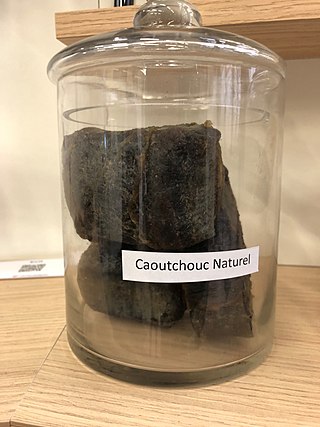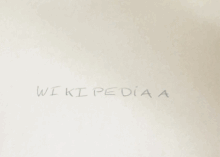
Blu Tack is a reusable putty-like pressure-sensitive adhesive produced by Bostik, commonly used to attach lightweight objects to walls, doors or other dry surfaces. Traditionally blue, it is also available in other colours. Generic versions of the product are also available from other manufacturers. The spelling now used is without a hyphen.

A pencil is a writing or drawing implement with a solid pigment core in a protective casing that reduces the risk of core breakage, and keeps it from marking the user's hand.

Rubber, also called India rubber, latex, Amazonian rubber, caucho, or caoutchouc, as initially produced, consists of polymers of the organic compound isoprene, with minor impurities of other organic compounds. Thailand, Malaysia, Indonesia, and Cambodia are four of the leading rubber producers.

In materials science, a thermosetting polymer, often called a thermoset, is a polymer that is obtained by irreversibly hardening ("curing") a soft solid or viscous liquid prepolymer (resin). Curing is induced by heat or suitable radiation and may be promoted by high pressure or mixing with a catalyst. Heat is not necessarily applied externally, and is often generated by the reaction of the resin with a curing agent. Curing results in chemical reactions that create extensive cross-linking between polymer chains to produce an infusible and insoluble polymer network.

A whiteboard is a glossy, usually white surface for making non-permanent markings. Whiteboards are analogous to blackboards, but with a smoother surface allowing for rapid marking and erasing of markings on their surface. The popularity of whiteboards increased rapidly in the mid-1990s and they have become a fixture in many offices, meeting rooms, school classrooms, public events and other work environments.
A penciller is an artist who works on the creation of comic books, graphic novels, and similar visual art forms, with a focus on the initial pencil illustrations, usually in collaboration with other artists, who provide inks, colors and lettering in the book, under the supervision of an editor.

Rubber cement is an adhesive made from elastic polymers mixed in a solvent such as acetone, hexane, heptane or toluene to keep it fluid enough to be used. This makes it part of the class of drying adhesives: as the solvents quickly evaporate, the rubber solidifies, forming a strong yet flexible bond.

Ethylene-vinyl acetate (EVA), also known as poly(ethylene-vinyl acetate) (PEVA), is a copolymer of ethylene and vinyl acetate. The weight percent of vinyl acetate usually varies from 10 to 50%, with the remainder being ethylene. There are three different types of EVA copolymer, which differ in the vinyl acetate (VA) content and the way the materials are used.
Paper Mate is a division of Sanford L.P., a Newell Brands company that produces writing instruments. Paper Mate's offices are located in Oak Brook, Illinois, along with those of Newell Rubbermaid's other office products divisions.
A writing implement or writing instrument is an object used to produce writing. Writing consists of different figures, lines, and or forms. Most of these items can be also used for other functions such as painting, drawing and technical drawing, but writing instruments generally have the ordinary requirement to create a smooth, controllable line.

Edward Nairne was an English optician and scientific instrument maker.
Lamy is a German pen manufacturing company founded in 1930 by Josef Lamy, a former sales representative for Parker Pen. The company acquired the Orthos pen manufacturer to begin production. Lamy is known for its innovative use of materials, particularly molded synthetic plastics in their pen designs.

A kneaded eraser, also commonly known as a putty rubber, is a pliable erasing tool used by artists. It is usually made of a grey or white unvulcanized rubber resembling putty or chewing gum. It functions by absorbing and "picking up" graphite and charcoal particles, in addition to carbon, colored pencil, or pastel marks. It neither wears nor leaves residue, thereby lasting much longer than other erasers.

An ink eraser is an instrument used to scrape away or chemically bleach ink from a writing surface. This is a more involved process than removing pencil markings. Pencil marks can be gradually adhered to natural rubber fragments by rubbing the mark with a pencil eraser Ink, however readily penetrates the fibers of most papers and is therefore more difficult to extract by mechanical action.

Drafting tools may be used for measurement and layout of drawings, or to improve the consistency and speed of creation of standard drawing elements. Tools such as pens and pencils mark the drawing medium. Other tools such as straight edges, assist the operator in drawing straight lines, or assist the operator in drawing complicated shapes repeatedly. Various scales and the protractor are used to measure the lengths of lines and angles, allowing accurate scale drawing to be carried out. The compass is used to draw arcs and circles. A drawing board was used to hold the drawing media in place; later boards included drafting machines that sped the layout of straight lines and angles. Tools such as templates and lettering guides assisted in the drawing of repetitive elements such as circles, ellipses, schematic symbols and text. Other auxiliary tools were used for special drawing purposes or for functions related to the preparation and revision of drawings. The tools used for manual technical drawing have been displaced by the advent of computer-aided drawing, drafting and design (CADD).

Artists' charcoal is charcoal used as a dry art medium. Both compressed charcoal and charcoal sticks are used. The marks it leaves behind on paper are much less permanent than with other media such as graphite, and so lines can easily be erased and blended. Charcoal can produce lines that are very light or intensely black. The dry medium can be applied to almost any surface from smooth to very coarse. Fixatives are used with charcoal drawings to solidify the position to prevent erasing or rubbing off of charcoal dusts.
Drafting film is a sturdier and more dimensionally stable substitute for drafting paper sometimes used for technical drawings, especially architectural drawings, and for art layout drawings, replacing drafting linen for these purposes. Linen and paper, such as bond and vellum, for reason of the organic origins like cotton, may shrink due to humidity and changes in the temperature.
Rubber-Tip Pencil Co. v. Howard, 87 U.S. 498 (1874), is an 1874 decision of the United States Supreme Court concerning the patent eligibility of abstract ideas. As explained below in the Subsequent developments section, it is intermediate in the development of that aspect of patent law from Neilson v Harford, through O'Reilly v. Morse, to Funk Bros. Seed Co. v. Kalo Inoculant Co., and then to Parker v. Flook, Mayo Collaborative Servs. v. Prometheus Labs., Inc., and Alice Corp. v. CLS Bank Int'l.



















